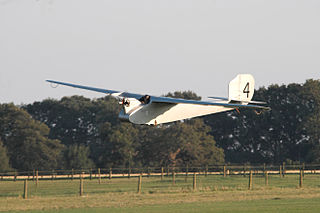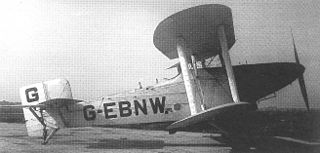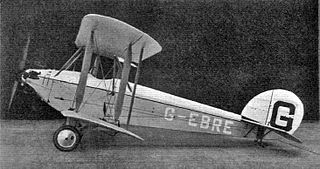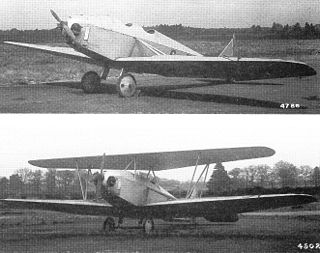| Avro 560 | |
|---|---|
 | |
| Role | Ultralight sportsplane |
| Manufacturer | A.V.Roe and Company Limited |
| First flight | 1923 |
| Introduction | 1923 |
| Number built | 1 |
The Avro 560 was a British single-engined ultralight monoplane built by Avro at Hamble Aerodrome.
| Avro 560 | |
|---|---|
 | |
| Role | Ultralight sportsplane |
| Manufacturer | A.V.Roe and Company Limited |
| First flight | 1923 |
| Introduction | 1923 |
| Number built | 1 |
The Avro 560 was a British single-engined ultralight monoplane built by Avro at Hamble Aerodrome.
The Avro 560 was designed for the 1923 light aircraft trials for single-seaters at Lympne Aerodrome. The Avro 560 was an ultralight built of wood-and-fabric construction, a cantilever high-wing monoplane. It was powered by a 698 cc (42.6 cu in) Blackburne Tomtit engine. The aircraft was flown by Bert Hinkler during the trials held in October 1923; the 560 did well and recorded an average of 63.3 mi (101.9 km) per Imp gal (4.5 L). The aircraft was evaluated by the Air Ministry after the trials but was not chosen for further production and only one 560 was built.
Data from Avro Aircraft since 1908 [1]
General characteristics
Aircraft of comparable role, configuration, and era

The de Havilland DH.53 Humming Bird is a British single-seat, single-engine, low-wing monoplane light aircraft first flown in the 1920s.

The ANEC I and ANEC II were 1920s British single-engine ultralight aircraft designed and built by Air Navigation and Engineering Company Limited at Addlestone Surrey. One was privately constructed in Brisbane, Australia.

The English Electric Wren was a 1920s British ultralight monoplane built by the English Electric Company Limited at Lytham St Annes, Lancashire.

The Avro Avian is a series of British light aircraft designed and built by Avro in the 1920s and 1930s. While the various versions of the Avian were sound aircraft, they were comprehensively outsold by the de Havilland Moth and its descendants.
The Avro 558 was a British single-engined ultralight biplane built by Avro at Hamble Aerodrome.

The Avro 571 Buffalo was a prototype British carrier-based torpedo bomber biplane, designed and built by Avro in the 1920s. It was not selected for service, the Blackburn Ripon being ordered instead.

The Avro 627 Mailplane was a British biplane developed in 1931 by Avro from the Avro Antelope bomber as a mail plane for use in Canada. Only one was built which ended up being used as a test bed.

The Blackburn L.1 Bluebird was a British single-engine biplane light trainer/tourer with side-by-side seating, built in small numbers by Blackburn Aircraft in the 1920s.
The Bristol Type 91 Brownie was a light sports aircraft produced in the United Kingdom by the Bristol Aeroplane Company in 1924. It was a low-wing cantilever monoplane aircraft of conventional configuration with fixed tailskid undercarriage. The pilot and passenger sat in tandem open cockpits. It won the £1,000 pound prize for second place at the Lympne light aircraft trials in October 1924.

The Supermarine Sparrow was a British two-seat light biplane designed by R.J. Mitchell and built at Supermarine's works at Woolston, Southampton. It first flew on 11 September 1924. After being rebuilt in 1926 as a parasol monoplane, it was re-designated Sparrow II.

The Westland Widgeon was a British light aircraft of the 1920s. A single-engined parasol monoplane, the Widgeon was built in small numbers before Westland abandoned production in 1929.

The Avro 562 Avis was a two-seat light biplane designed and built by the A.V.Roe and Company Limited at Hamble for the 1924 Lympne Light Aeroplane Trials.

The Gloster Gannet was a single-seat single-engined light aircraft built by the Gloucestershire Aircraft Company Limited of Cheltenham, United Kingdom, to compete in the 1923 Lympne Trials. Engine development problems prevented it from taking part.
The Gnosspelius Gull was a 1920s British experimental ultra-light monoplane designed by Major O.T. Gnosspelius and built by Short Brothers at Rochester for the 1923 Lympne light aircraft trials.

The Blackburne Tomtit was a 670 cc V-twin aero engine for light aircraft that was designed and produced by Burney and Blackburne Limited. Burney and Blackburne was based at Bookham, Surrey, England and was a former motorcycle manufacturer.
The Handley Page H.P.22 and H.P.23 were single-seat sport monoplanes produced for the 1923 Lympne light aircraft trials. They were not successful.

The Parnall Pixie was a low powered British single-seat monoplane light aircraft originally designed to compete in the Lympne, UK trials for motor-gliders in 1923, where it was flown successfully by Norman Macmillan. It had two sets of wings, one for cross-country flights and the other for speed; it later appeared as a biplane which could be converted into a monoplane.
The Lympne Light Aircraft Trials were held to encourage the development of practical light aircraft for private ownership, with a strong but not exclusive emphasis on fuel economy. They were held in 1923, 1924 and 1926. Each year saw different restrictions on engine size, framed initially in terms of capacity and then weight. The Daily Mail newspaper provided cash prizes throughout though the initiating donation came from the Duke of Sutherland. The Air Ministry were prize givers in the 1924 event. The trials were held at Lympne in Kent, England.
The Pegna-Bonmartini Rondine, or Pegna Rondine, is a single-seat ultralight sport aeroplane designed by Giovanni Pegna and built by Piaggio in Italy during 1923.
The Gribovsky G-5 was a small, low powered Russian single seat sports aircraft from the late 1920s.